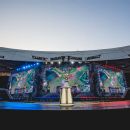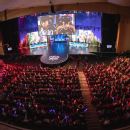North America’s Cloud9 and China’s Royal Never Give Up advanced out of Group B in the League of Legends World Championship round robin phase in Busan, South Korea.

Check out recaps, features and video from the biggest tournament of the year.

Tyler Erzberger, Ashley Kang and Emily Rand look back on the League of Legends world championship performances thus far and share their outlook on what might happen in the rest of the group stage.
2 Related
They did the opposite of what North America as a region has done for its existence at worlds.
Let me break it down for you. For years, the NA LCS has come into worlds and done well in the first half of the double-round robin group stage. This isn’t a coincidence or some kind of magic. Almost every year, NA LCS teams come with a prepared style or a single strategy they are good at, deploy it in its first three games, get a few wins, and then go into the second half of the group with little motivation to adapt or change. During the days off, the opposing teams analyze their tunnel vision, exploit their weaknesses, and dispose of them when they meet again.
In 2015, the only year of C9’s existence in League of Legends in which they didn’t make the quarterfinals at worlds, the team got off to by far its best start of any world championship, going 3-0 in the first week before crashing back down to earth in Week 2 with four straight losses. The past two years, all three NA LCS teams have finished the first week with 2-1 records. Both years, only C9 clawed their way out of the group stages, with the likes of Team SoloMid, Immortals and Counter Logic Gaming unable to evolve their play from the first three games to the last three.
This year, C9 was flat-footed up until their final games of Group B. The play-in stage was a near-disaster. Japan’s Detonation FocusMe almost beat them twice. In the knockout match with LCL’s Gambit Esports to get into the group stages, the team almost got eliminated before even making it to Busan, surviving 3-2. And while they stole a win from Team Vitality in the first set of games in Group B to salvage at least one win, it didn’t feel like a complete victory — the win felt more like Vitality losing the game through overeagerness than C9 winning.
On Sunday, the team who failed to make it out of groups, Team Vitality, might be the ones who actually helped C9 the most to move into the knockout stage. Through the first half of the group stages, a standard meta had established itself with champions like Urgot and Kai’sa becoming staples of nearly every game. Team Vitality, sick and tired of single-damage comps or boring farm fests in the top lane, bucked the trend, falling back to their all-out aggressive style to take out Gen. G in the first set of games and open the eyes of C9 who felt they were too passive in their first few games.
Coming into the final three games, C9 adopted the approach Team Vitality had brought to South Korea: Fight. It doesn’t matter if your brain is telling you one thing and your heart is telling you another — fight.
And fight they did. Instead of playing champions that have been “meta” this event, C9 played to their strengths and quickened their play. Eric “Licorice” Ritchie, the team’s burgeoning rookie superstar, played four different champions in four games with Hecarim, Poppy, Shen, and Singed. Nicolaj “Jensen” Jensen got his hands on his signature Zilean. From top to bottom, the team’s mindset was to let everything out on Summoner’s Rift, and be it a win or a loss, like Team Vitality, they would not go down without taking a few of the opposing team with them.
The result was the best single-day performance in North American history at worlds. In succession, C9 bested Gen. G, romped tournament-favorite RNG, and then, in one of the best worlds matches of the last few years, defeated Team Vitality to qualify for the quarterfinals, the two innovative western sides both selecting their pocket picks like Zilean and Ekko to see which region’s flavor was better on the day. Vitality, opting for an early-game composition, couldn’t get a large enough lead around their core Draven, and before too long, C9 was sprinting their way to the top-8, becoming the first NA LCS team to mightily improve from the first half of the group stage to the next.
Gen.G, the world champion, was the perfect standardized team. In the face of mages and other wacky champions becoming meta in the bottom lane in the early part of the summer, Gen. G never flinched. They continued playing their standard ways. It didn’t matter if they didn’t have the best early game or the best laners. Gen.G knew in the end, when they got to their sweet spot, no team could defeat them.
That mindset is what killed the king. Vitality set the tone of a new meta at worlds, and C9 followed suit. RNG, who was toppled in their first two games of Sunday’s slate, eventually adapted as well by the final tiebreaker for the No. 1 seed in the group with C9, besting the NA team in another nail-biter. The only team to not evolve throughout the tournament, Gen.G, finished with only one win.
Adapt or die is the new name of the game in South Korea.
Group B has changed the entire feel of the tournament and other teams will almost assuredly follow the new meta set. In what has become an arms race to see which team can play the fastest and be the tempo-setters of each game, it will be down to which teams can evolve the fastest to see who will join C9 and RNG for the quarterfinals this weekend.
Team Vitality might have not made it to the quarterfinals, but the tone they set through their swagger and flair in how they approach the game definitely will. C9 will make sure of it.
Powered by WPeMatico


